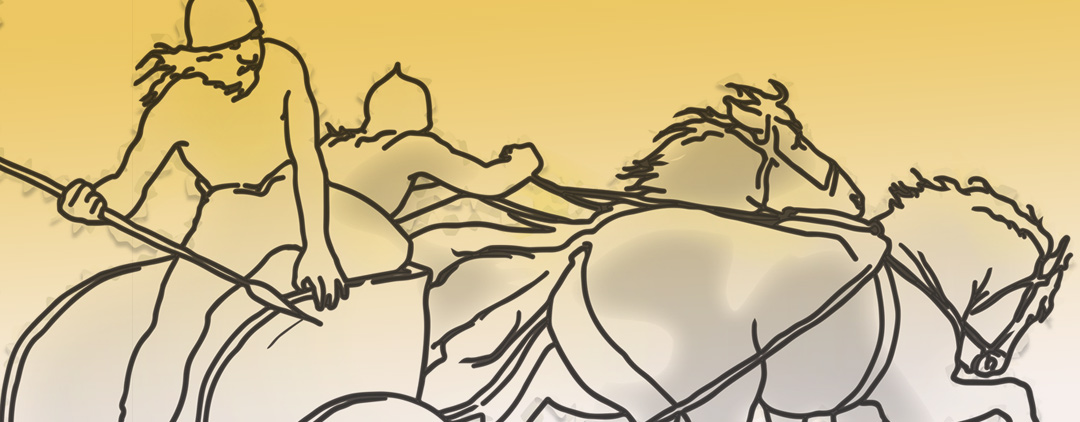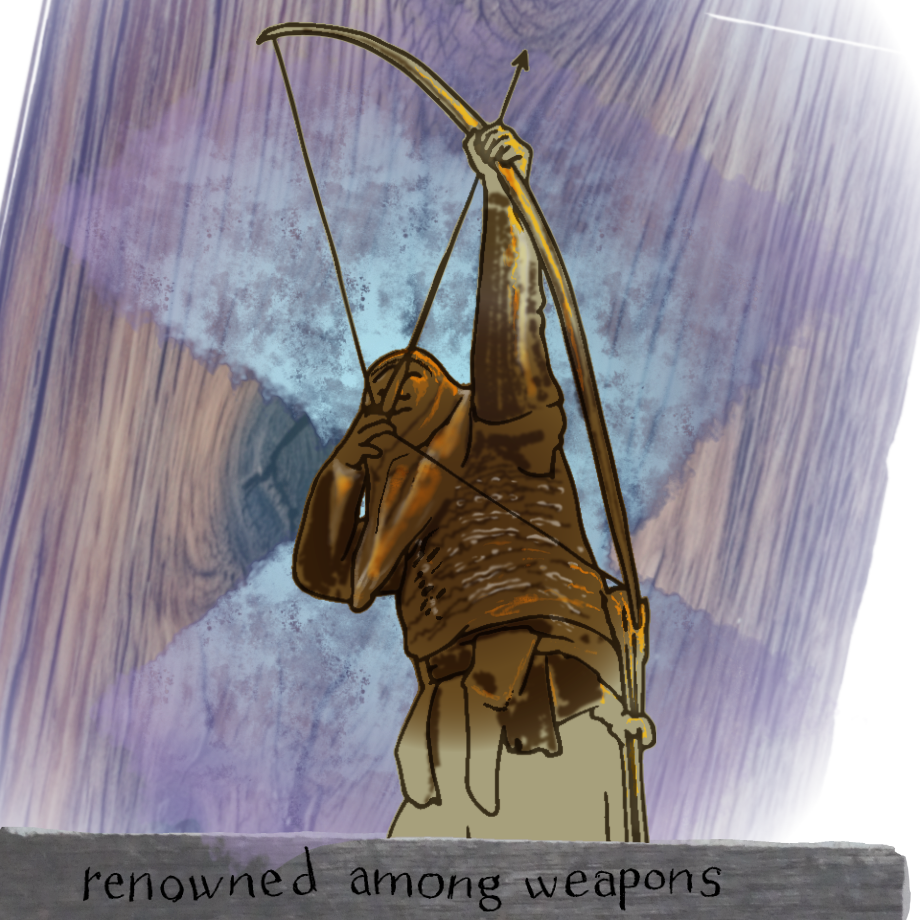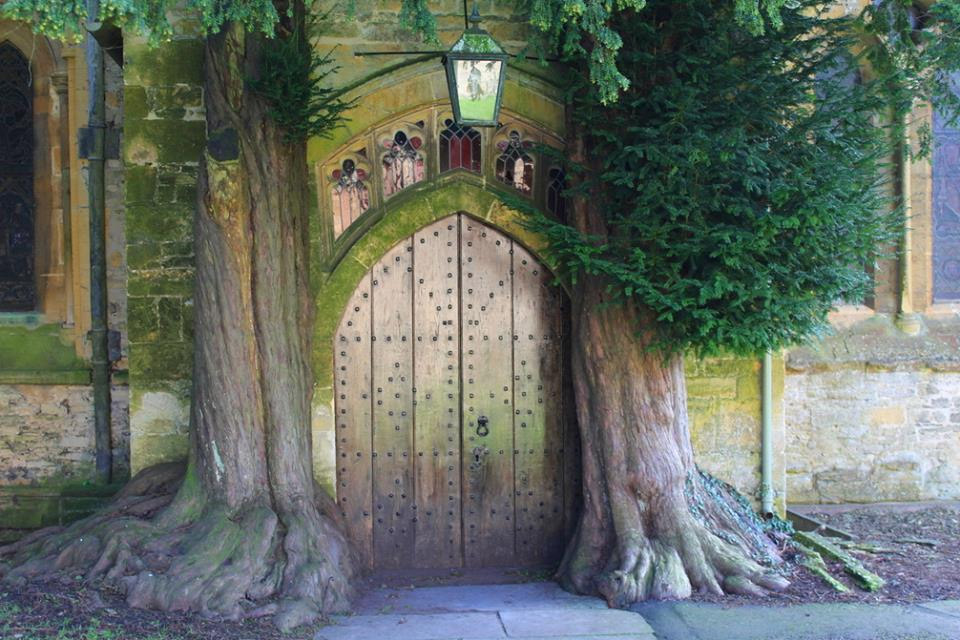
B L N F S H D T C M G P R A O U E I Q


san aona sgial, craobh ì,
nan tùs, nan draoidh,
a thug fasgadh, san sgial eile,
do mhàthair phìleat, an
neo-chiontach 's e ris a chìch,
ciste-laighe nan iomadh cuach
a chuireas lasair anns a chuirm
slat chruaidh an rioghlaidh,
craobh bith-bhuannachd,
craobh farsuing bàis
crann a ruigeas sìos dhan uaigh,
ceum dhan anam, sgùradh cuirp
seall, nan oisein, iubhar 's abhall,
mar a tha am meanglan àrda suaint
troimh chéile, càraid òg san uaigh
biodh i tearc, biodh i na mùr fiodha
mun cuairt air seann falamhachd,
tha i beò, tha a h-eachdraidh buan
in the first tale, it named
iona of the druids
it gave shelter, in the other tale,
to pilate's mother, his
innocence at her breast
coffin of the many goblets
that give radiance to the feast
hard rod of government
tree of immortality
wide tree of death
tree that reaches down into the tomb,
a soul's way out, will cleanse the corpse
see, in their places, yew and apple,
how their upper branches twine
together, young lovers in the grave
it may be rare, it may be a timber wall
around an ancient emptiness,
it is alive, its history is secure
Yew typically is a dense evergreen tree, of no great height, but instead with one or more massive trunks of very hard wood of dark, reddish bark and dark green, needle-like leaves.
These leaves are flattened and soft (unlike pine), spirally placed on their shoots, which makes their scarlet berries (arils) stand out easily in the autumn. Although the bark can peel off in strips, creating patterns, yew is otherwise unlike the pine, in that it contains no resin and, apart from the arils, all parts of the tree are highly poisonous, which would normally be a form of protection.
A most remarkable thing about the yew is that it is almost immortal. With its very slow growth and extraordinary regenerative ability, yew is the essence of longevity and resurrection. It can sprout again, even after losing its branches.
Whilst there are many trees that can produce new shoots after being cut down (hazel), or being storm-damaged (willow), and although others have root suckers (poplars) that are effective ways of reproducing themselves, none have the third way of reproducing themselves, as yew does, through the layering process - a highly unusual method in trees. Layering happens when a branch touches the ground and begins to put down roots from this point of contact. In time, if these roots grow sufficiently strong, then they are able to develop a new tree, independent of the original source. Sometimes however, they may never become entirely independent, but rather continue the growing process by surrounding the initial mother tree with further trees - as at Ormiston (East Lothian).
However, yew has yet a further surpise because, as old wood within the trunk begins to rot naturally, a protective skin of new growth may start from inside it, shielding the new growth and allowing the yew to resurrect iself from the outside in.
If the growth of the cambium layer keeps up with the rate of decay (at an increase in girth of about one inch per twenty-five years, or for solitary trees about one inch per year), the result is that a yew that appears to be a hollow, decayed wreck is in reality simply self-regenerating. Out of death comes resurrection. There is no biological reason for a yew tree to die - it can virtually live forever.

Together with boxwood, the wood of yew is the hardest of any tree in temperate zones, and very enduring. And it is not simply for sacred reasons that yew is significant. Its wood has been highly prized for practical reasons for centuries. A yew spear found in Clacton, Essex, dates from about 150,000 years ago and is the world's oldest man-made artifact. A yew bow, dated at 2,600 BC, was found in Somerset, yet a hill walker at Carrifran Wildwood (Scottish Borders), discovered an older one still in 1990. It was an abandoned hunting bow of 6,000 years old, found in the peat bogs there, that preserved it. And there is the 5,300 year old Iceman discovered on the Italian-Austrian border, who had a yew bow measuring six feet although he himself was only 5'2" tall.


The reason yew is now found mainly in churchyards stems largely from historical demand. Edward III, in 1369, made a law that every able-bodied man must be practiced in archery.
This entailed plundering of the natural yew forests, so much so that by 1492 England had to begin importing yew wood. Parliament then passed a law that every trading ship unloading in an English harbour be taxed four yew bows per ton of freight. The result of this was that nearly one million yew bows came to England within the next half century from the continent and no yew trees were left in Bavaria by 1568

The Eihwaz symbol that in old Futhark defined yew, somehow answers the 'beginning and end' that belongs to this tree of the Winter Solstice. Represented by the thirteenth rune, eihwaz, which is generally understood to represent death and rebirth, this yew rune is in the shape of a zigzag.
Yews have been associated with sacred centres for thousands of years. The Fortingall yew (Perthshire), at over 5,000 years old and among the oldest living trees in the world, sits on the northern side of Carn nam Marbh (Mound of the Dead), an ancient Bronze Age tumulus. The builders of Stonehenge, Avebury, Calanais and Newgrange, all planted yews on the north side of their burial mounds.
After 2,500 BC, yews were instead grown on the east-west axis of the tumuli, a fact that remained true for Celtic sites, and only later, when the Anglo-Saxons arrived in Britain, did the planting of yews at sacred sites change to a southern aspect.
It is an astonishing fact that the yew tree at Discoed in Wales was possibly already about five hundred years old when the first bluestones from the Prescelli mountains passed it on their way to be made into Stonehenge - and that same tree is still alive! The arils (once called apples) are both bright and the only edible part of the tree.


Another later rune for Yew, yr, represents the roots of the Tree of Life. An early ninth-century yew wand from Holland, with Anglo-Saxon runes carved in it as invocation to calm the waves of the sea is one among many objects found made of yew wood. Another is one of one-eyed Odin. It dates from the eleventh century BC and was found in Britain, implying an older and not exclusively Norse origin to his mythology. Indeed, Yggdrasil, the world tree, is a yew rather than the ash usually assumed. The old Norse barraskr ('needle-ash'), is described as evergreen (in an old Old Norse song it is described as wintergreenest tree).
As well as the principle wood for carving ogham runes, druids used yew staffs with notches or oghams to record the phases of the moon or the traditional laws (Fife 1994). An old Irish word for salmon is eo, the same as the word for yew. The Eburones, Esuvii and Eburomagus are all celtic tribes named after the yew and one Swiss settlement was called Eburodun.

Ireland actually means 'Yew Island', (the Greeks and Romans calling it Ierne and Iubernia respectively), and Iona is similarly another island whose root is yew (hI, ee, y, all being forms of the same word). In ancient poems, yew berries are described as either nuts (the hard green fruits), acorns (the arils sit in small cups) or apples (red fruits were often called apples in the past).
The word tann is common to the root of Beltane (Bel's fire) and tann (sacred tree), which originally referred to yew, the red tree. Glastonbury - or glas tann bury - translates as 'ever-green sacred tree'. Excavations around the well at Glastonbury revealed the stump of a yew tree at a depth of twelve foot. While apples likely played a part at Avalon (ubhal being apple), most certainly so too did yew!

From Danu (Aine, Anu) came the Fir Sidhe, or Tuatha de Danaan, three of whom were yew trees. Herself a daughter of the Dagda, Danu had a sacred hill, Cnoc Aine, in Munster dedicated to her, containing the genealogy of the kings of Ireland. Her brothers were named 'green foliage' and 'fork in a yew tree' (Fer hI meaning 'man of yew'). Danu herself therefore is associated with the yew and later peoples respected this family of yew children as the first race of the yew island, with the Eoganacht ruling Munster from the seventh to the tenth century AD.
The graves of Deidre and Naoise were separated by King Conchobar using yew stakes, but they grew into trees weaving their branches together, uniting the lovers in death. Tristan and Iseult were similarly separately buried, but the yew tree on their graves eventually intertwined above the chapel separating them. Countless customs and stories from the Christian era refer to the yew as the graveyard tree of Tir nan Og (land of youth) and in Wales it is referrred to as 'the gentle guardian of the dead'.
